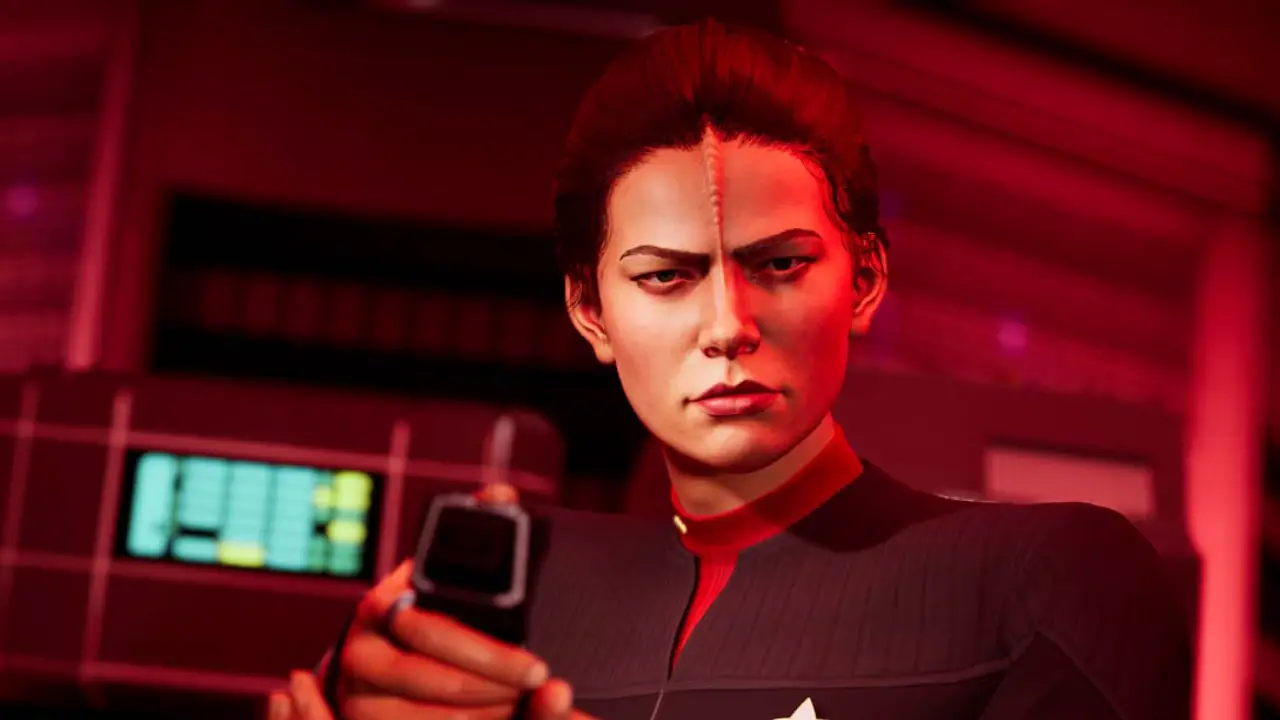
Star Trek is and has always been a human drama. It takes place in space, it’s full of jargon both real and imaginary, but from its start in 1966 all the way through to the conclusion of the most recent entry in 2023’s Star Trek: Picard, this series is about interpersonal and interspecies interactions. You’d figure it would have more entries than Call of Duty with as rich a universe Star Trek has made, but the videogame adaptations of this universe have been painfully uneven. The ones that have been most successful have capitalized on that human element, and the ones that failed spectacularly thought Star Trek was a show about combat. Dramatic Labs understands this and wanted to bring that drama to life in a game where storytelling is key. Star Trek: Resurgence is their maiden voyage. Let’s set a course for the future and see if a small independent studio can pull off what major studios have failed to do time and again.
Star Trek: Resurgence takes place in the Star Trek: The Next Generation time frame, and represents a side story that thankfully doesn’t put you in the captain’s seat. You won’t be playing as Picard, Sisko, Janeway, or any other primary character, instead playing as a freshly-assigned XO for the U.S.S. Resolute, Commander Jara Rydek.
The U.S.S. Resolute has just been rebuilt after a horrific accident almost destroyed the ship, killing several crew members and shaking the crew’s resolve. As we ride the shuttle to the Resolute we meet the other main character of the game, Petty Officer Carter Diaz, an Engineer assigned to work in the lower decks of the Resolute.
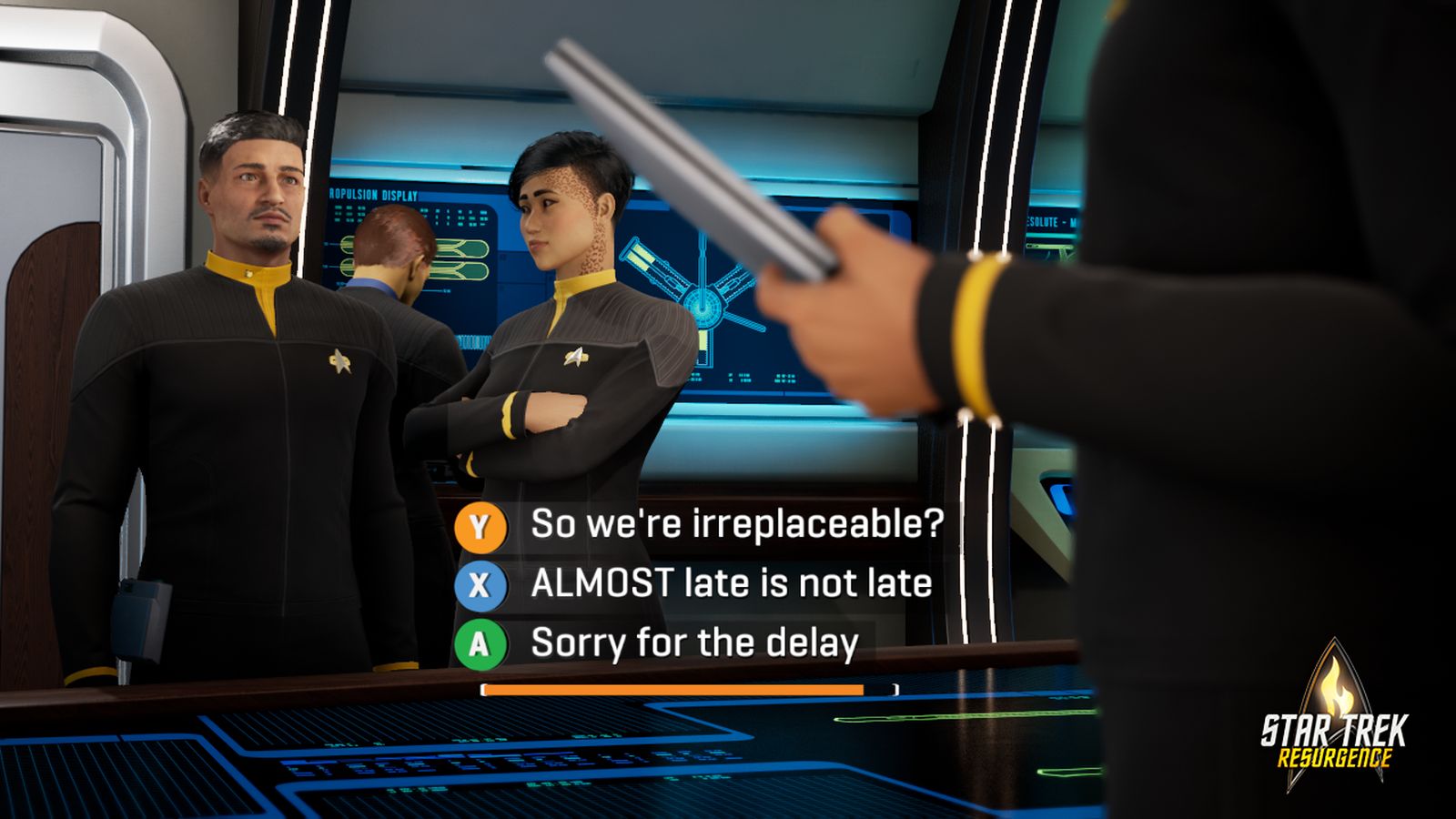
At its heart, Star Trek: Resurgence is an interactive story, so it should come as no surprise that Dramatic Labs is headed by the prior CEO of Telltale Games, Kevin Bruner. He’s joined by Brett Tosti who served as Executive Producer and Executive Director of 11 Telltale games, Kent Mudle who served as Cinematic Director on five Telltale titles, Dan Martin who served as writer for Telltale’s The Walking Dead, Game of Thrones, and Batman, and Andrew Grant, Creative Director on Telltale’s Game of Thrones, Minecraft: Story Mode, as well as The Walking Dead and Batman: The Enemy Within. If, like me, you were expecting a longer list of developers, then you can be as surprised as I am – this game was made by just five people. Frankly, I’ve played dozens of games with teams 10x as big that didn’t play this well.
With story being the primary focus, and ex-Telltale folks at the helm, you probably have an idea of how this game will play. Free of the previous engine and embracing both Unreal and their own proprietary tech called “Beanie”, the game emphasizes storytelling, but also interaction. Telltale titles were typically about quicktime events and saying the right thing at the right time. Here there are innumerable interactions. You’ll scan with your tricorder, use all manner of maintenance tools to pry open compartments and fiddle with the insides, catch a falling data pad, twist, turn, and swipe all manner of interactive screens, adjust frequencies, and so much more. You’ll even occasionally use phasers, though combat is far from the focus here. Even cleaning the corrosion of a battery node means executing several quicktime events, button and stick presses, and combinations therein. While Star Trek: Resurgence is very much focused on storytelling, it’s the most interactive kind of storytelling.
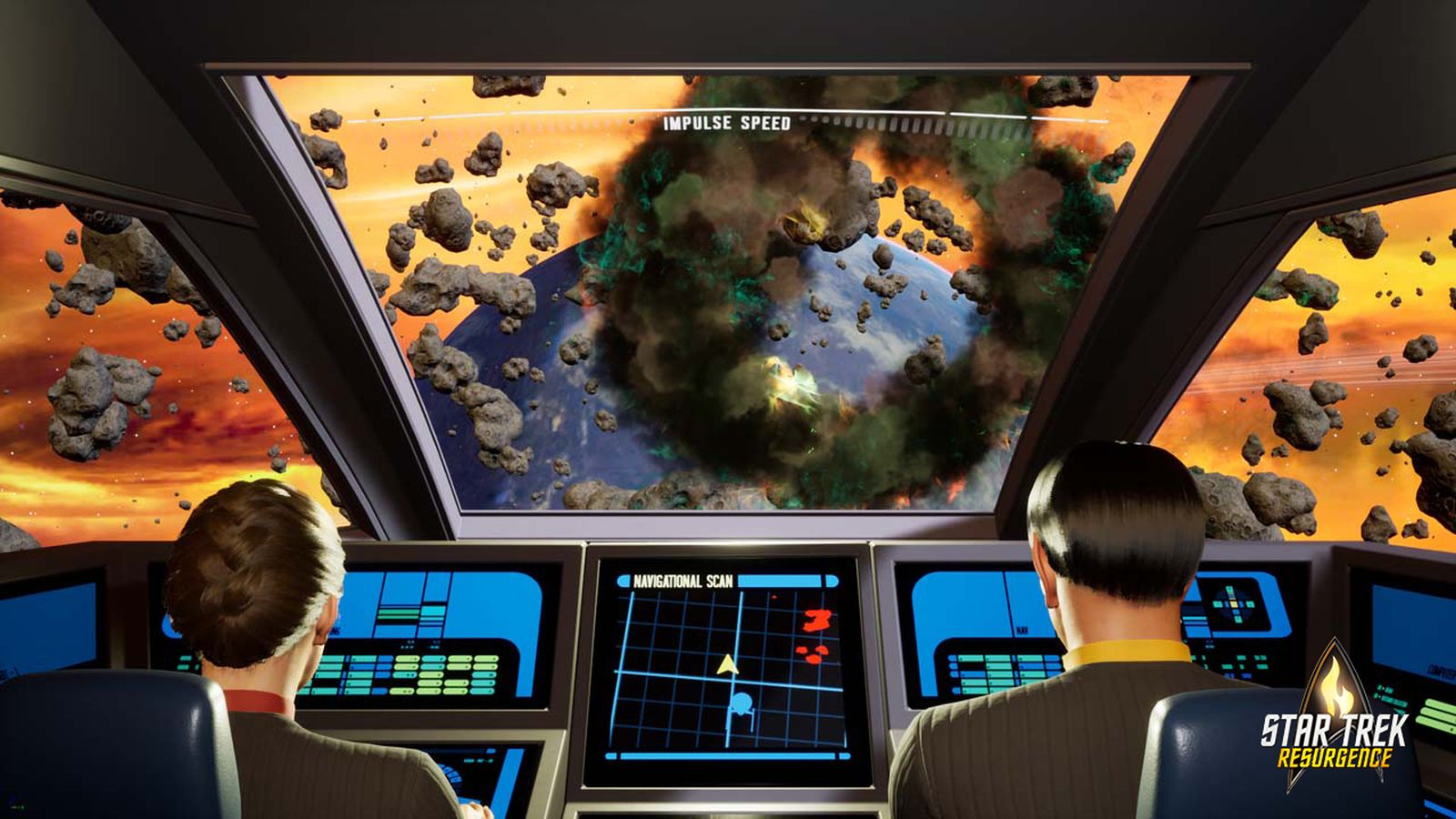
Given that the game does have a number of quicktime events popping up at any given moment, you’d think you wouldn’t be able to watch the action unfold. Thankfully, Dramatic Labs has worked very diligently to make this game as cinematic as possible. Quicktime events typically unfold precisely where you are looking anyway, meaning you are rarely looking away from the action. Better still, they make sense. When you are pushing a lever and then a second person joins in, you’ll go from holding the right trigger and pushing the left thumbstick to pushing both thumbsticks with your combined efforts.
As you progress through the story you’ll frequently be given the opportunity to shape it through dialogue choices. Some of them are seemingly mundane, but if you’ve played a game like this you’ll know better. They start off simple enough, but quickly you are deciding the potential fate of characters who are stuck in dangerous situations and could die. Within an hour you are picking sides in what looks to be the kickoff of a massive intergalactic war over who will control the largest source of dilithium in the galaxy. Just because you aren’t a Kirk, Picard, or Archer doesn’t mean you can’t make big and bold decisions.
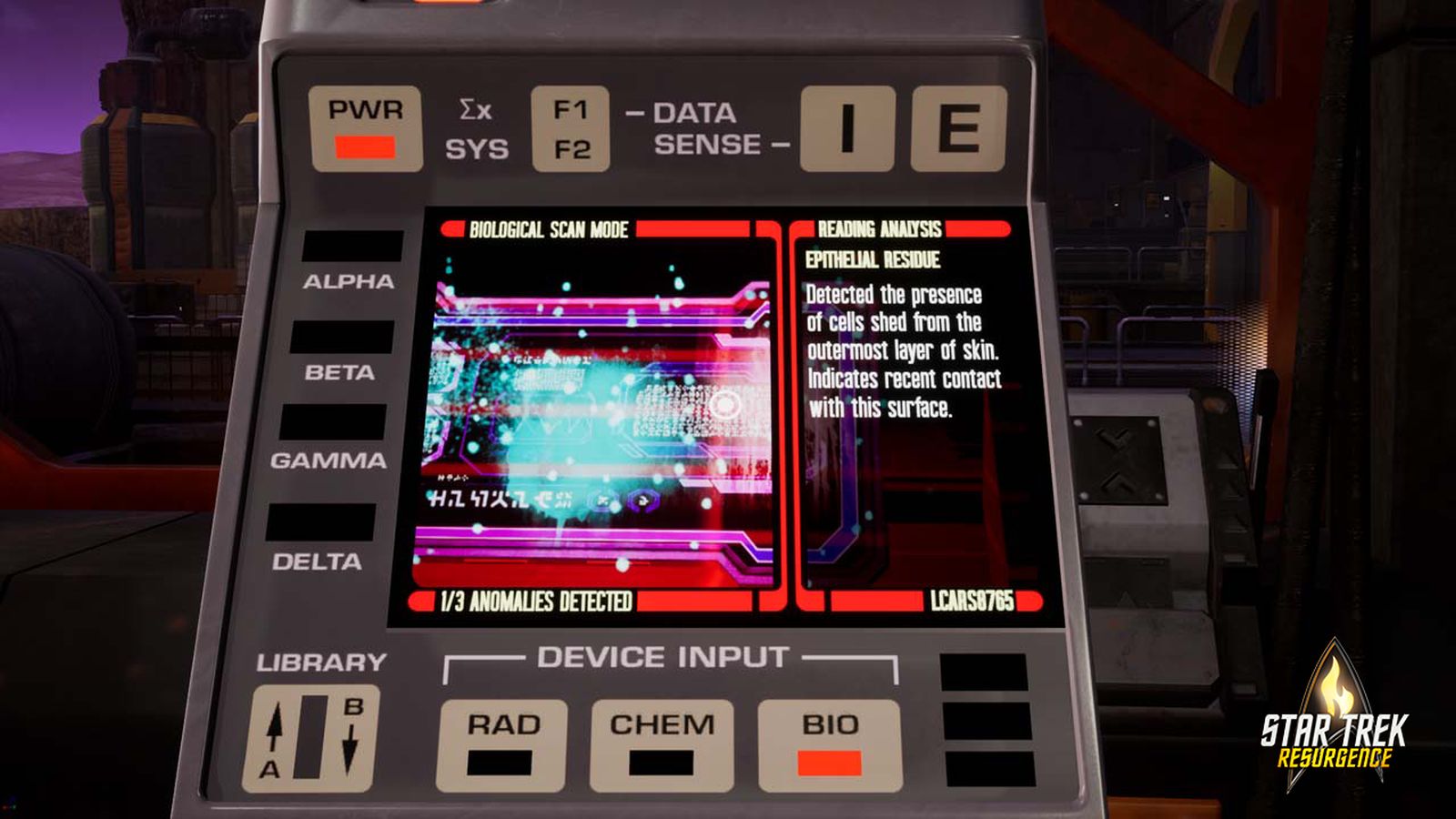
These dialogue choices are presented with a timer. In Telltale titles, the games put pressure on you with this timer, because not making a choice is still a choice. Unfortunately, that pressure is lost here when you let it run out and nothing happens. The screen goes black and white and waits for you to make whatever decision. It takes out some of the teeth of these decisions when they are no longer impulsive, meaning you have time to think them through before you take action. This pressure was one of the primary reasons I’d replay titles like this, but with different choices, so I feel like this is a misstep.
If you are inclined to revisit the game, and honestly some of the decisions are so polarized that I feel like it’d be warranted for at least one more run, if not more, you can get a closer look at the impact of your decisions from the main menu. You’ll be given a QR code or a code to take a look at your decisions and their impacts. It’d be nice to see them in the game rather than bouncing us to another website, but at least it’s an option.

From the second the game starts you’ll feel like you are watching an episode of the show. Dramatic Labs understands the subject matter as they absolutely nail the pacing and feel of an episode of Star Trek: The Next Generation. In fact, as you pass through the various save points in the game you’ll get a chapter name just like an episode of the show. Similarly, every ship, station, uniform, badge, and rank pip is pulled straight from lore. The LCARS interface present on the walls, the regulations cited, and the layout of the ship feels like it could have been pulled from any number of highly-detailed schematics.
The sound effects in Star Trek: Resurgence are absolutely perfect. Why? They are pulled directly from the archives of Paramount’s movies and shows. That means replicators, phasers, deck doors, and the LCARS computer system sounds precisely as it should. I can’t express just how much this adds to the immersion, but when it’s done right, it’s done right. Even the music swells, ebbs and flows, and jumps when the scene demands. For example, as Captain Solano recounts the tragic events that befell the ship six months before your arrival, the music is inspiring as he describes how amazing the ship and his team are, and then gets fairly reflective when he walks us through the tragic events in specific, and how we can help help get the crew and ship back on mission.
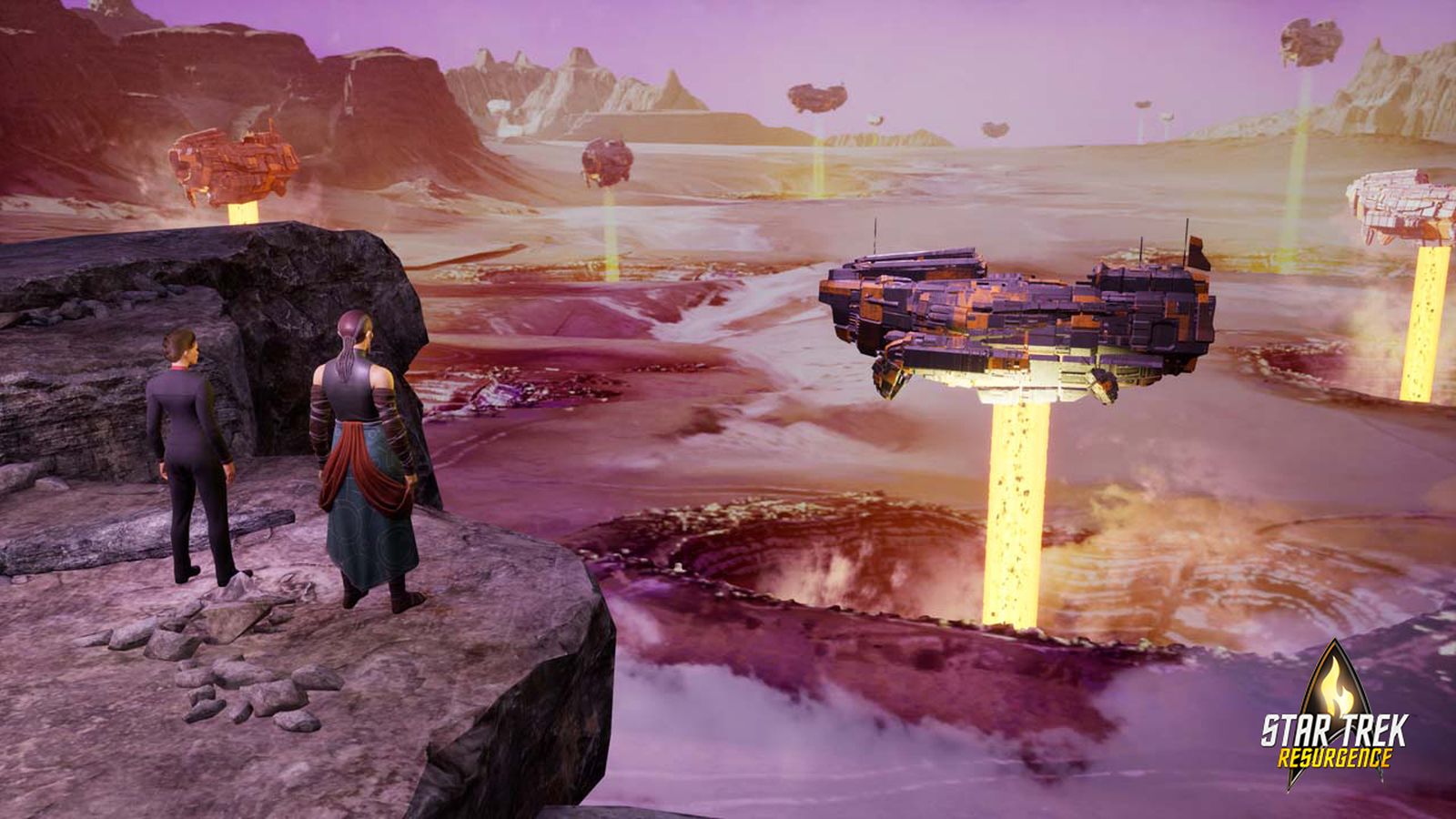
For a game focused on narrative elements to work, you need excellent voice actors. Frankly, I’m shocked at just how great Dramatic Labs did with their casting. Every single character sounds like they could easily be top tier actors. Your lower deckers sound like inexperienced and brash young enlisted members. Your officers have a gravitas that comes with the grave responsibilities of command. Krizia Bajos (Transformers: Earthspark, Gotham Knights, Moonbreaker, Saints Row, Apex Legends and more) is great as Jara Rydek, Josh Keaton (Metal Gear Solid 3: Snake Eater, Dragon Age: Absolution, Voltron: Legendary Defender, The Callisto Protocol, Midnight Suns) delivers as Carter Diaz, and Stephanie Sheh (Sailor Moon, American Dad, Tactics Ogre: Reborn, and a shedload of anime) does solid work as Nili Edsilar. Elias Toufexis (he’s Adam Jensen in Deus Ex, after all) is excellent in everything he does, so it’s no surprise that he knocks it out of the park as Galvan. JP Karliak (Star Wars: The Bad Batch, Minions: The Rise of Gru, Spidey and His Amazing Friends, Elex II) gives us his best slightly-irritated deadpan as Vulcan Commander Chovak. The standout star among this stellar list, however, has to be Piotr Michael. His depiction of Ambassador Spock is absolutely magnificent. Honestly, if he doesn’t get a nomination for Best Voice Actor at The Game Awards, then this whole system is rigged and broken. I could go on and on, but I think you get the point – these are veterans in their field, and this game is better for it. You might even catch a familiar voice or two that I won’t spoil here, but as a lifelong Trekkie, I couldn’t help but smile like a dummy.
While the team has absolutely nailed the look, sound, and atmosphere of the shows and movies, there’s one area that can be rather hit and miss – the characters. Facial expressions are all over the place, sliding between concerned, mad, and upset like you are dragging a slider between presets. It can be a bit jarring, or can send the wrong message on what a character’s intentions are before making decisions. Thankfully, while the faces are occasionally a little odd, they do serve the purpose well enough. Frankly, after playing for a short while you really stop noticing in favor of paying attention to your assigned duties.
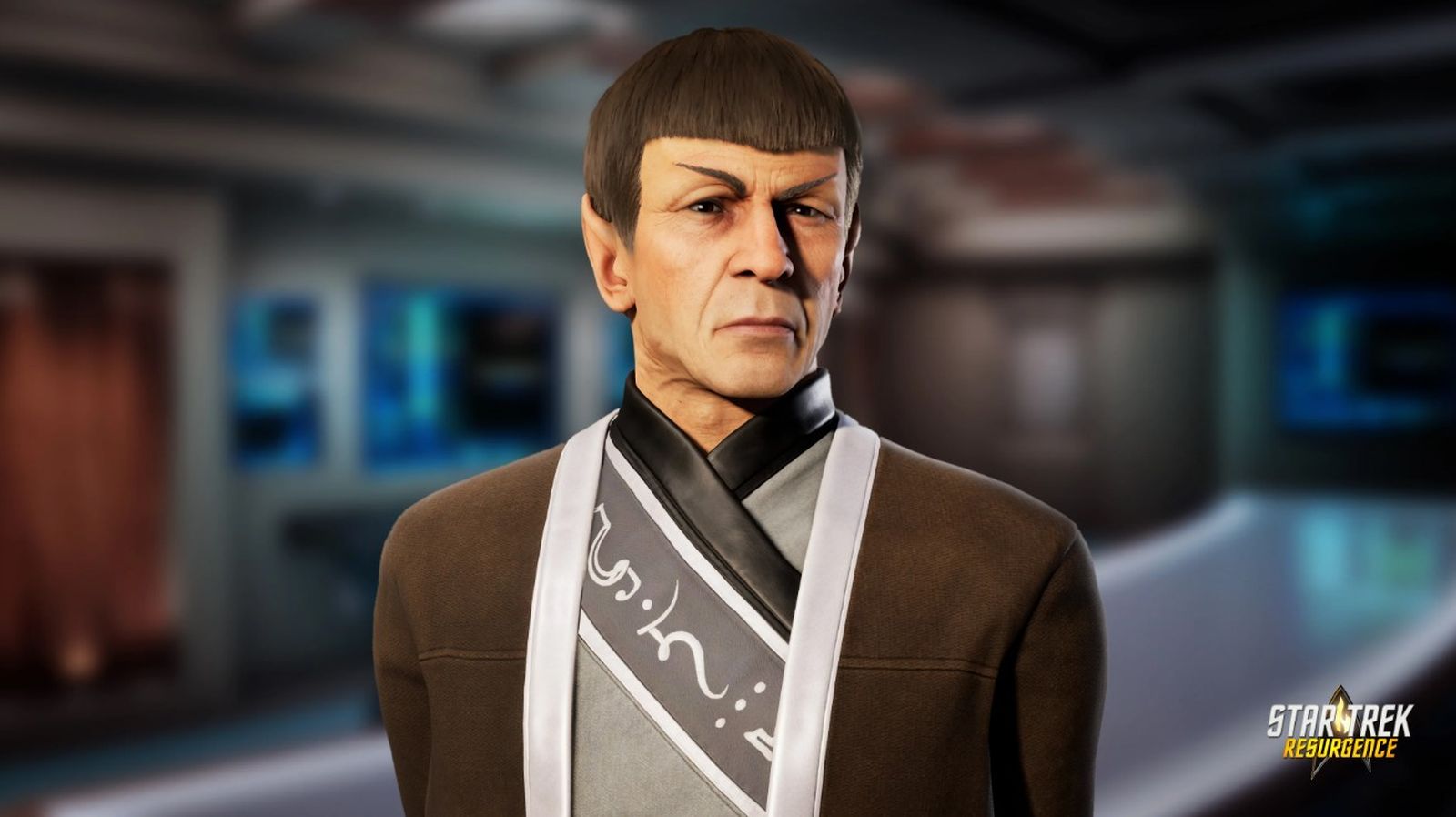
When you do make decisions, you’ll see a small card in the corner that indicates how that choice was received. Even in the first interaction with Diaz we have the option to admonish him for dropping his data pad and being a “nervous flier” being assigned to literally sail the stars. You can also give him tips on how to handle a bit of turbulence and reassure him that he’ll be fine. No matter what choice you make, these interactions will be remembered, though I’m going to guess most folks will play it straight, at least the first time around.
I was surprised to see that the team has managed to integrate a stealth section into the game. It’s certainly not a focus of the game, but it breaks up the walk, talk, interact routine nicely. It’s similar to the way Bloober Team dropped a mid-game stealth section into the middle of one of their horror games – it’s not an unwelcome addition, but it’s probably not what you came for.
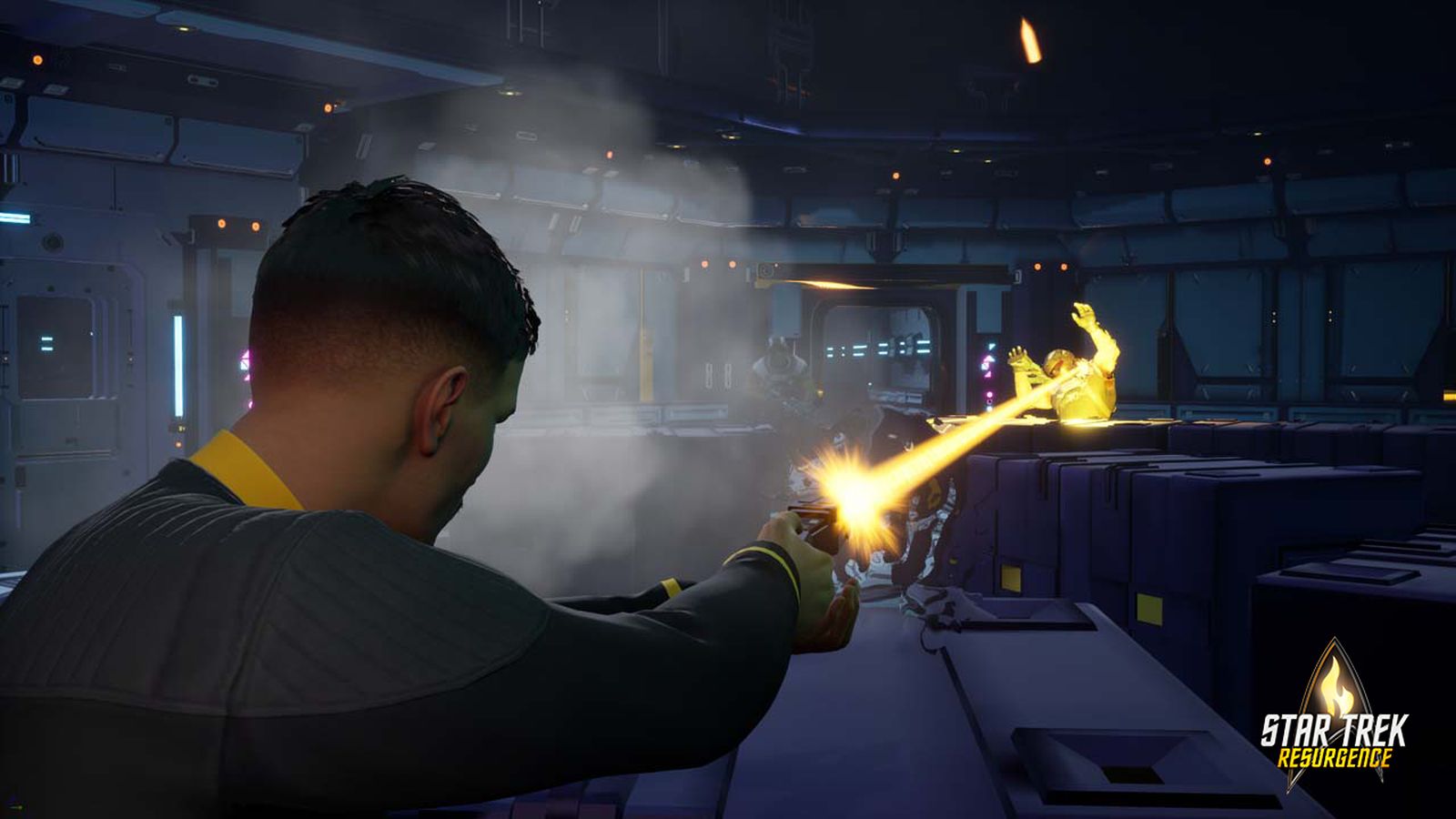
There are still a number of bugs, despite the small delay to the game. I’ve had my character’s head disappear into my neck, some odd animations snap into position, and for some reason I can’t select 4K resolution – it’s just unavailable. When selecting resolution I also lost the use of my controller until I’d reset my resolution again. Thankfully all of it is cosmetic, but there is still work to be done here.
Most bafflingly, however, are the occasional framerate hits. I’m running bleeding edge gear – an RTX 4090, DDR5, Intel 13900K processor, and PCIe 5.0 for storage, but occasionally I’ll see stuttering and hiccups from the game at the most innocuous of times. Simply panning around a scene where nothing is happening can trigger it. Sometimes I’ll see the framerate plummet when shifting from player control to conversation cutscene. A bit of optimization is needed.
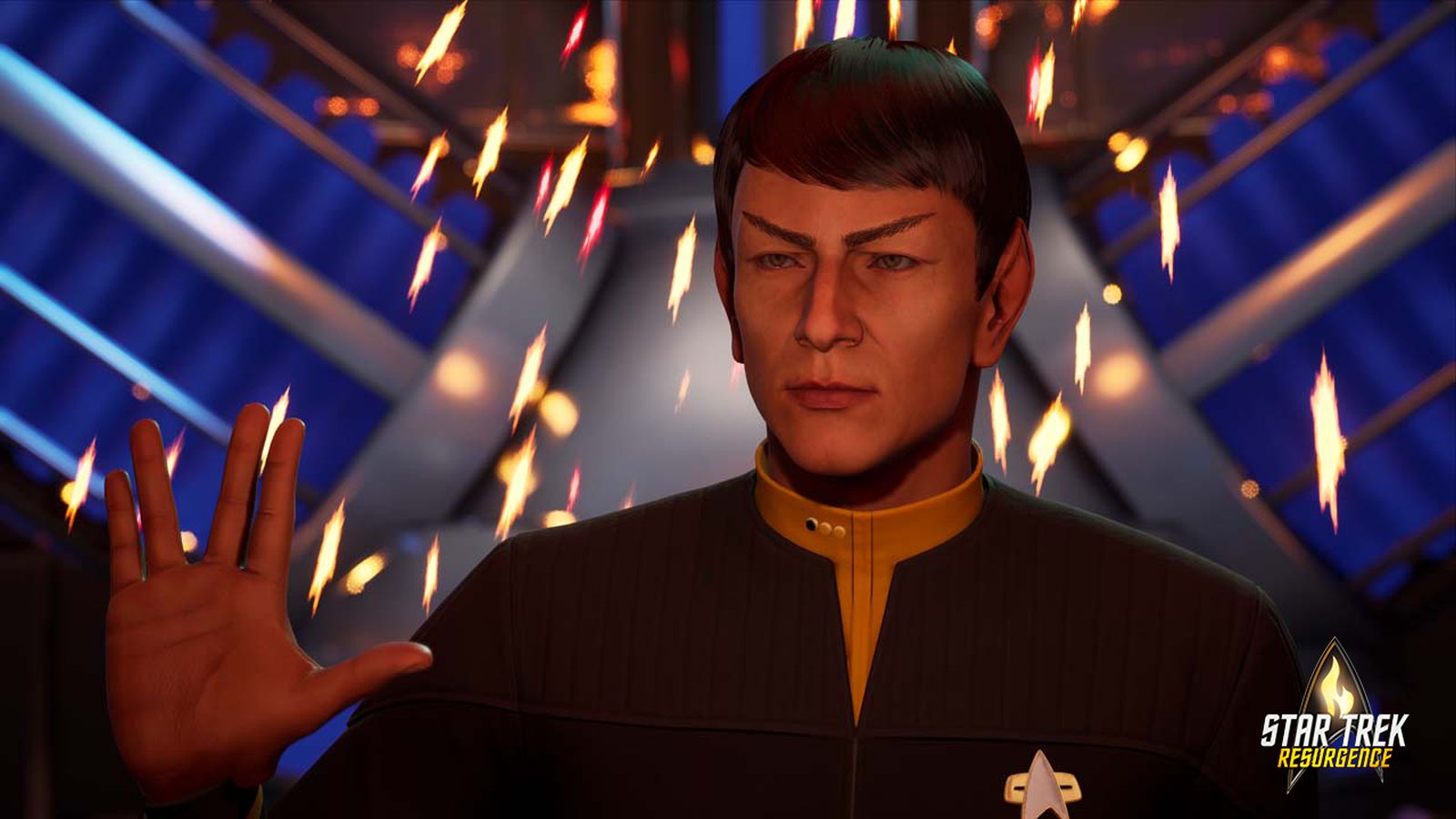
My only real complaint is that Star Trek: Resurgence plays it too safe. There is a Story Mode for those who want to experience the game on easy (and no shame in that – there’s a great story here!), but the regular settings don’t apply the sort of pressure needed on the player. It’s almost impossible to fail, and without failure, the stakes aren’t as high.
Ultimately Star Trek: Resurgence feels like the best parts of Star Trek: The Next Generation and the films, but with the flexibility and intrigue of a longer running medium. The storyline is excellent, as is the voice work, sounds, and overall feel of the game. I was happy to see a greater emphasis on interactive storytelling instead of merely reacting, and this feels like a very solid foundation for whatever Dramatic Labs tackles next. Me? I’m ready for more Trek, and I hope that Paramount gives them the opportunity – this is the best Star Trek game I’ve played in over a decade.
Star Trek: Resurgence
Great
Filled to bursting with all the Trek-no-babble, easter eggs, in-jokes, and political intrigue you’ve come to know and love from the Next Generation era of Trek, Resurgence hits all the right notes, even if it does play it a bit safe. Now if we can just get the rest of the Tribbles out of Jeffries tubes…
Pros
- Absolutely phenomenal voice work
- More emphasis on interaction in the interactive storytelling
- An excellent story that feels like peak Trek
- Decisions feel impactful
- Piotr Michael must win an award or this world is broken
Cons
- It’s almost impossible to fail
- Some graphical oddities and framerate hitching
- Occasional cosmetic bugs
